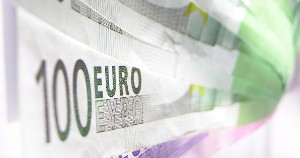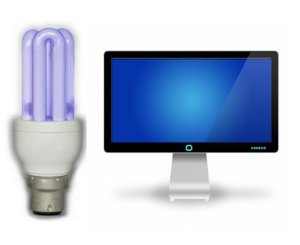The chemical element europium is classed as a lanthanide and rare earth metal. It was discovered in 1901 by Eugène-Antole Demarçay.

Data Zone
| Classification: | Europium is a lanthanide and rare earth metal |
| Color: | silvery-white |
| Atomic weight: | 151.96 |
| State: | solid |
| Melting point: | 822 oC, 1095 K |
| Boiling point: | 1600 oC, 1873 K |
| Electrons: | 63 |
| Protons: | 63 |
| Neutrons in most abundant isotope: | 90 |
| Electron shells: | 2,8,18,25,8,2 |
| Electron configuration: | [Xe] 4f7 6s2 |
| Density @ 20oC: | 5.248 g/cm3 |
Reactions, Compounds, Radii, Conductivities
| Atomic volume: | 20.8 cm3/mol |
| Structure: | bcc: body-centered cubic |
| Hardness: | |
| Specific heat capacity | 0.18 J g-1 K-1 |
| Heat of fusion | 9.210 kJ mol-1 |
| Heat of atomization | 178 kJ mol-1 |
| Heat of vaporization | 175.73 kJ mol-1 |
| 1st ionization energy | 546.7 kJ mol-1 |
| 2nd ionization energy | 1085 kJ mol-1 |
| 3rd ionization energy | 2405 kJ mol-1 |
| Electron affinity | – |
| Minimum oxidation number | 0 |
| Min. common oxidation no. | 0 |
| Maximum oxidation number | 3 |
| Max. common oxidation no. | 3 |
| Electronegativity (Pauling Scale) | 1.12 |
| Polarizability volume | 27.7 Å3 |
| Reaction with air | vigorous, ⇒ Eu2O3 |
| Reaction with 15 M HNO3 | mild, ⇒ Eu(NO3)3 |
| Reaction with 6 M HCl | mild, ⇒ H2, EuCl3 |
| Reaction with 6 M NaOH | – |
| Oxide(s) | Eu2O3 (Europia) |
| Hydride(s) | EuH2 |
| Chloride(s) | EuCl3 |
| Atomic radius | 185 pm |
| Ionic radius (1+ ion) | – |
| Ionic radius (2+ ion) | 131 pm |
| Ionic radius (3+ ion) | 108.7 pm |
| Ionic radius (1- ion) | – |
| Ionic radius (2- ion) | – |
| Ionic radius (3- ion) | – |
| Thermal conductivity | 13.9 W m-1 K-1 |
| Electrical conductivity | 1.1 x 106 S m-1 |
| Freezing/Melting point: | 822 oC, 1095 K |

Fittingly, europium is used in the euro currency as an anti-forgery measure. Shining UV light on a euro results in red fluorescence from europium Eu3+, blue from thulium Tm3+ and green from terbium Tb3+.
Discovery of Europium
The story of Europium’s discovery begins with the discovery of another element – samarium.
French chemist Paul-Émile Lecoq de Boisbaudran claimed to have isolated samarium in 1879; others believed that one or more other new rare earth elements were present in Boisbaudran’s sample.
In 1886, French chemist Eugène-Antole Demarçay identified spectroscopic lines in ‘samarium’ caused by the element we now know as europium. (1)
He achieved this using a new spectroscope he had developed to study the rare earths.
Demarçay’s spectroscope had a special induction coil which produced a very high spark temperature and used platinum electrodes to remove all other spectral lines. (2)
Demarçay’s spectral results were disputed and he realized that he needed further proof.
He obtained this in 1901, when he successfully isolated europium using repeated crystallizations of samarium magnesium nitrate. (1),(3)
He named the new element after the continent of Europe.
In 1904 europium was separated from impure gadolinium by French chemist Georges Urbain using bismuth magnesium nitrate. Urbain discovered that bismuth nitrate will often crystallize between two fractions of rare earth elements making it easier to separate them. (1)


Europium is used to produce blue, red and white radiances in computer monitors and television screens. It is also used in energy efficient light bulbs.
Appearance and Characteristics
Harmful effects:
Europium is considered to be mildly toxic. The metal dust is considered to be a fire and explosion hazard.
Characteristics:
Europium is a soft, ductile, silvery-white metal that instantly oxidizes in air.
It is the most reactive of the rare earth metals and ignites in air at temperatures in excess of 150 oC to 180 oC.
In water it reacts in a similar way to calcium, producing europium hydroxide and hydrogen gas.
Unlike most other rare earth metals, europium can form stable compounds in the divalent state, Eu2+ (europous) as well as the usual trivalent state, Eu3+ (europic).
Uses of Europium
Europium oxide (europia) is widely used as a doping agent in phosphors in television sets and computer monitors: valency three europium produces a red radiance and valency two europium produces a blue radiance. When both valencies are combined a white light is produced which is used in compact fluorescent bulbs.
Europium is also used in phosphors in anti-forgery marks on Euro bank notes.
Europium isotopes are good neutron absorbers and are used in nuclear reactor control rods.
Abundance and Isotopes
Abundance earth’s crust: 1.8 parts per million by weight, 0.2 parts per million by moles
Abundance solar system: 0.5 part per billion by weight, 4 parts per trillion by moles
Cost, pure: $1350 per g
Cost, bulk: $20,000 per 100g
Source: Europium is not found free in nature but is found in a number of minerals mainly monazite, bastnaesite and xenotime. Commercially, europium is isolated by ion exchange and solvent extraction. The pure metal can be produced by the electrolysis of the molten chloride with sodium chloride.
Isotopes: Europium has 30 isotopes whose half-lives are known, with mass numbers 131 to 162. Naturally occurring europium is a mixture of its two stable isotopes, 151Eu and 153Eu with natural abundances of 47.8% and 52.2% respectively.

References
- Ferenc Szabadváry, Handbook of the Chemistry and Physics of the Rare Earths Vol. 11., Elsevier Science Publishers., 1998, p65.
- Per Enghag, Encyclopedia of the elements: technical data, history, processing, applications., John Wiley and Sons, 2004, page 450.
- John Emsley, Nature’s building blocks: an A-Z guide to the elements., Oxford University Press, 2003, p140.
Cite this Page
For online linking, please copy and paste one of the following:
<a href="https://www.chemicool.com/elements/europium.html">Europium</a>
or
<a href="https://www.chemicool.com/elements/europium.html">Europium Element Facts</a>
To cite this page in an academic document, please use the following MLA compliant citation:
"Europium." Chemicool Periodic Table. Chemicool.com. 16 Oct. 2012. Web. <https://www.chemicool.com/elements/europium.html>.
great website for school projects
amen brother!
This is great website for a Europium project